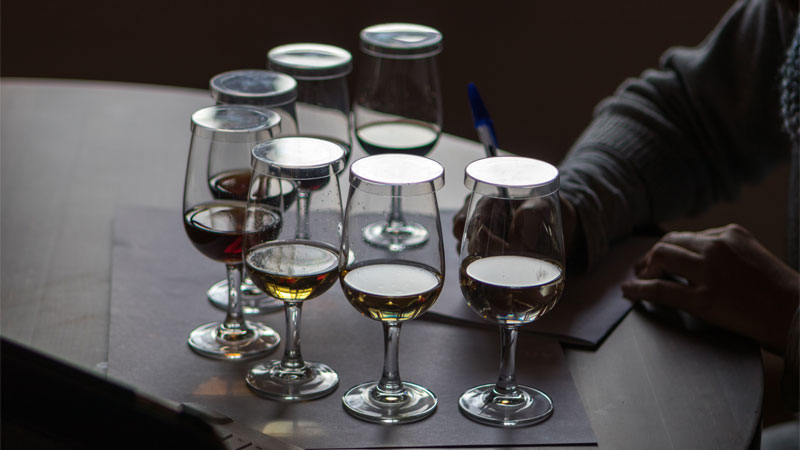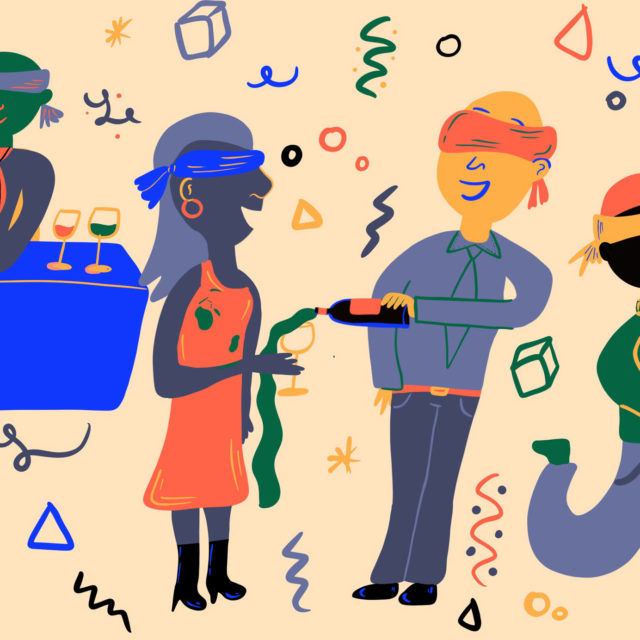Unlike those of us who spend our evening commutes trying desperately to think about anything but work, employees of importer Skurnik Wines used theirs to hone their blind-tasting abilities. In 2014, Skurnik staffers would share bottles and sip from plastic cups on commuter trains home from Long Island, N.Y., trying to determine the grape variety, origin, and vintage of different wines by taste and smell alone.
“The glassware wasn’t ideal,” admits brand manager Gabriel Clary, “but it was about honing our sense of taste and creating associations between grape variety and place. We still blind-taste almost every day, but just not on a train any longer.”
The ability to identify a wine “blind” might seem like little more than a party trick to those outside the wine trade, but many industry professionals believe it’s an invaluable skill. It can directly improve sommeliers’ service, advocates say, and eliminate biases. While it’s certainly not without its flaws, the intentions of blind tasting are noble, and it’s arguably the best method of remaining objective in certain situations.
How do you blind-taste, exactly? Some rely on the tasting grids provided by educational bodies such as the Court of Master Sommeliers and the Wine and Spirits Education Trust (WSET). The grid guides them to identify different characteristics, including appearance, aromas, flavors, and texture. By assessing these characteristics, and calling upon theoretical knowledge, proficient tasters can identify a wine.
One key component of blind-tasting is typicity, or the degree to which a wine represents the typical grape varieties, climate, soils, and winemaking practices of its origin. Identifying a wine blind is hugely reliant on it being a good representative of its category, or showing “typicity.”
“Finding typicity and quality level are the most important things in blind tasting,” NYC-based Master Sommelier Dana Gaiser says. “It’s very hard to critically analyze a wine if you can’t recognize it blind.”
Sommelier-turned-winemaker and celebrated blind-taster Rajat Parr agrees. When Parr assembled the wine program at San Francisco’s Fifth Floor in 1999, he tasted all the potential wines for his list blind. His criteria for inclusion were simple: “If I could identify the wine, the region, and a rough price point, then I would consider buying it,” he says.
But linking quality to typicity can come with shortcomings. In quality winemaking regions, local appellations dictate aspects of production, ranging from grape varieties used to vineyard practices and aging techniques. These controls have helped strengthen the notion of typicity — but just because something has always been done a certain way doesn’t mean that should be the only way.
Take Super Tuscan wines. In the 1970s, a handful of Italian winemakers decided that Bordeaux varietals aged in new French oak would be better suited to their coastal terroir. Typicity was the last thing on their minds. Now, wines in this category, including Sassicaia, Ornellaia, and Tignanello, rank among the most revered (and expensive) in Italy. Conforming to the idea of typicity would have deprived the world of these bottles.

Blind tasting can also help overcome both positive and negative biases. “A lot of people chase cult producers and the ‘greatest wines,’ but if they can’t tell you blind whether it’s a grand cru or village level wine from Burgundy, that kind of negates the whole point of spending all the money on a grand cru,” Gaiser says.
Meanwhile, blind tasting wines from larger-scale wineries — an uncool category for some sommeliers — can help individuals overcome their production prejudices, Gaiser says.
Perhaps the most famous blind tasting of all time is the 1976 Judgment of Paris. During the historic tasting, judges from France, Britain, and the U.S. deemed a California Chardonnay to be better than bottles from Burgundy, and a California Cabernet Sauvignon to be better than the finest Bordeaux blends. At the time, it was front-page news.
Unfortunately, blind tasting is not an exact science. “I find emotion changes the way you recognize wines very quickly,” Gaiser says. “The more stressed you are the tougher tasting is.”
Tasters are only human, after all. In 2005, California winemaker Robert Hodgson approached the organizers of the California State Fair wine competition with an experiment: Each of the competition’s four judges would be presented with a flight of wines. Within each flight, certain wines would be poured three times — each glass from the same bottle.
Unbeknownst to the judges, Hodgson carried out his experiment over four years. The results were staggering.
Only 10 percent of the judges were consistent in their scoring. Those who were consistent one year were less so the next. Results from the first four tastings showed that judges’ scores varied by an average of plus or minus four points over the three glasses. This means that a judge might have scored a wine 90 points when they tasted it from one glass, but then also judged it an 86 when it was poured elsewhere.
Perhaps blind tasting’s biggest shortcoming is how far removed it is from consumers’ purchasing habits. Chicago-based wine professional Belinda Chang saw this firsthand when she hosted a luncheon in the city’s chic Gold Coast neighborhood. She thought it would be fun to do a “blind bubbles challenge.” Each of the attendees had little or no experience tasting wine this way.
“I wanted to get them to really pay attention to the wine, and to codify what they do and don’t like to help them understand their tastes,” she recalls.
Chang poured four bottles: a Prosecco, a Cava, a non-vintage Champagne, and an old vintage of Dom Perignon. After tasting the wines, each of the ladies voted for their favorite by raising their hands. At least 95 percent voted for the Prosecco. When she revealed their favorite bottle, the tasters were mortified and embarrassed. “Afterwards, I asked what they wanted another splash of, and they all asked for the Dom Perignon, which they truly did not enjoy,” she says.
Blind tasting can be revealing for novices and pros. We just don’t always like what we see.
